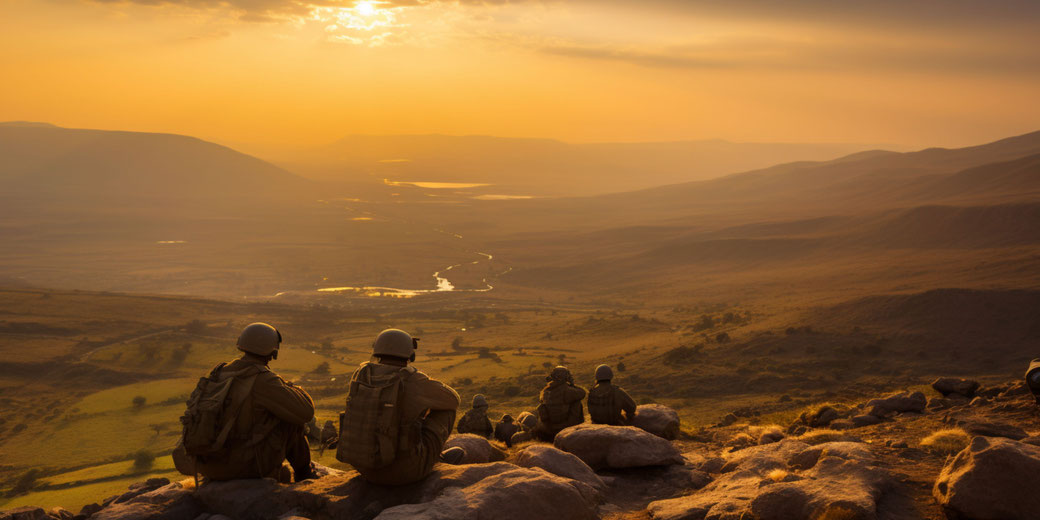Yom Kippur War: The surprise invasion of Israel from all sides in 1973

The Yom Kippur War, also known as the October War, erupted in 1973 and dramatically altered the political landscape of the Middle East.
Initiated by a coalition of Arab states led by Egypt and Syria, the war aimed to reclaim territories lost to Israel during the Six-Day War in 1967.
The conflict began with a surprise attack on Israel during the holiest day in the Jewish calendar, Yom Kippur, catching the Israeli defense forces off guard.
Over the course of 19 intense days, both sides experienced significant victories and losses, with the war ultimately leading to a shift in regional dynamics.
What were the causes of the Yom Kippur War?
The roots of the Yom Kippur War can be traced back to the aftermath of the Six-Day War in June 1967.
In that brief conflict, Israel achieved a resounding victory against Egypt, Jordan, and Syria, capturing the Sinai Peninsula, the West Bank, the Gaza Strip, East Jerusalem, and the Golan Heights.
These territorial gains significantly expanded Israel's borders but also intensified tensions with its Arab neighbors.
The loss was deeply felt in the Arab world, leading to a collective desire for revenge and the recovery of lost territories.
Following the Six-Day War, a prolonged period of hostilities known as the War of Attrition (1967-1970) ensued, primarily along the Suez Canal.
Egypt, under President Gamal Abdel Nasser and later Anwar Sadat, engaged in sporadic warfare against Israeli positions, aiming to weaken Israel's hold on the Sinai.
On the diplomatic front, the Khartoum Resolution of September 1, 1967, adopted by Arab leaders, famously declared "no peace with Israel, no recognition of Israel, no negotiations with it."
By the early 1970s, both Egypt and Syria were preparing for a full-scale war to reclaim their territories.
Egypt's Sadat, in particular, felt that a military victory, even a limited one, could provide the leverage needed for a diplomatic solution.
Israel, on the other hand, was confident in its military and air superiority and believed that its Arab adversaries would not risk another confrontation given the outcomes of previous wars.
How the invasion was planned
Egypt's President Anwar Sadat, who had succeeded Gamal Abdel Nasser in 1970, was a central figure in this build-up.
Recognizing the need for a strategic shift, Sadat expelled Soviet military advisors from Egypt in July 1972, a move that both asserted his independence from the USSR and obscured his military preparations from Israeli intelligence.
Throughout 1973, Egyptian troops conducted large-scale exercises near the Suez Canal, which, over time, desensitized Israeli observers to troop movements, making it harder to discern genuine threats from routine drills.
Syria, under President Hafez al-Assad, was also gearing up for conflict. The Golan Heights, lost to Israel in 1967, was a sore point for the Syrians, both for its strategic elevation and its symbolic value.
Throughout 1972 and 1973, Syria bolstered its military capabilities with the help of the Soviet Union, receiving advanced weaponry and undergoing intensive training.
While these preparations were underway, Israel remained largely complacent.
The Israeli military and intelligence community operated under the assumption, known as the "Concept", that Egypt would not go to war without first acquiring long-range bombers and advanced missile systems to neutralize the Israeli Air Force.
This belief was so deeply ingrained that clear warnings of an imminent attack, including a last-minute alert from a reliable source on October 5, 1973, were dismissed or downplayed.
The surprise attack begins
At 2pm on October 6, 1973, as the sun began to set and many Israelis were observing the Yom Kippur fast, a day of atonement and the holiest in the Jewish calendar, a sudden and coordinated military onslaught was launched by Egypt and Syria.
The date was no coincidence; the Arab states had chosen it precisely because they believed Israel would be least prepared.
Egyptian forces initiated their assault across the Suez Canal on the southern front, which involved over 100,000 soldiers crossing the canal within the first 24 hours, supported by a barrage of 2,000 artillery guns.
Under the cover of an intense artillery barrage, Egyptian engineers rapidly deployed water cannons to breach the massive sand barriers of the Bar-Lev Line, Israel's defensive fortification along the Suez Canal.
In a matter of hours, they managed to create several openings, allowing tens of thousands of Egyptian soldiers to cross the canal into the Sinai Peninsula.
Accompanied by tanks and supported by anti-aircraft missiles that kept the Israeli Air Force at bay, the Egyptians quickly established bridgeheads on the eastern bank of the canal.
Simultaneously, to the north, Syrian forces mounted a massive attack on the Golan Heights.
With a combination of infantry, tanks, and artillery, they aimed to break through Israeli defenses and descend into the Galilee.
The initial assault saw significant Syrian gains, as they managed to penetrate several kilometers into the Golan, capturing a number of strategic points.
Israel was caught largely unprepared. The speed and intensity of the Arab offensive, combined with the element of surprise, initially overwhelmed Israeli defenses.
Reserve forces, which formed the backbone of the Israeli military, were urgently mobilized, but this took time.
Those on the front lines, vastly outnumbered, fought tenaciously to hold their ground and buy time for reinforcements to arrive.

How Israel turned the tide
In the Sinai Peninsula, one of the most intense battles took place near a location known as the Chinese Farm, situated at a crucial crossroads northeast of the Great Bitter Lake.
From October 15 to October 17, Israeli and Egyptian forces clashed in a chaotic and ferocious engagement.
Amidst the dust and confusion, Israeli forces aimed to clear a path for their advancing armor to cross the Suez Canal and encircle the Egyptian Third Army.
After days of heavy combat, the Israelis managed to secure a corridor, enabling them to construct a bridge across the canal.
Once across the Suez, Israeli forces began to push westward, threatening to cut off the Egyptian Third Army from its supply lines and effectively encircle it.
The Israeli forces under General Ariel Sharon, successfully crossed the Suez Canal at the Deversoir area on October 16, establishing a critical foothold on the western bank.
This maneuver not only halted the Egyptian advance into the Sinai but also shifted the strategic balance, placing Israel in a position to threaten Egypt's heartland.
To the north, on the Golan Heights, the situation was equally dire for Israel in the early days of the war.
Syrian forces had made significant inroads, capturing key positions. However, from October 7 to October 10, the tide began to turn.
At locations like Booster Ridge and the Valley of Tears, Israeli defenders, despite being heavily outnumbered, managed to repel Syrian armored divisions, inflicting heavy losses.
By October 11, Israeli forces had not only halted the Syrian advance but began a counter-offensive, pushing deeper into Syrian territory and approached within 40km of the outskirts of the city of Damascus by the war's end.

How the war almost turned nuclear
The Yom Kippur War was not just a regional conflict; it drew the attention and involvement of global superpowers, particularly the United States and the Soviet Union, both of whom sought to protect their interests and allies in the Middle East.
From the outset, both superpowers were keenly aware of the stakes. The United States, under President Richard Nixon and Secretary of State Henry Kissinger, was a staunch ally of Israel.
As the war progressed and the initial Arab successes became apparent, Israel found itself in dire need of military resupplies.
In response, the US initiated Operation Nickel Grass on October 14, a massive airlift that delivered crucial weapons, ammunition, and supplies to Israel: totaling over 22,000 tons of supplies to Israel in just 32 days.
This American support was instrumental in bolstering Israel's military capabilities and morale during the war.
The Soviet Union, on the other hand, had vested interests in supporting its Arab allies, especially Egypt and Syria.
Moscow provided both nations with substantial military aid, including advanced weaponry and advisors.
It even conducted a large-scale airlift to resupply Egypt and Syria, delivering an estimated 15,000 tons of military equipment, including tanks, missiles, and artillery.
As the war's tide began to turn in favor of Israel, and with Israeli forces advancing closer to Damascus and threatening to encircle the Egyptian Third Army, the Soviets grew increasingly alarmed.
They considered direct intervention to prevent a total defeat of their allies.
Amidst the fighting, diplomatic channels were buzzing. Kissinger embarked on what became known as "shuttle diplomacy", traveling between Middle Eastern capitals to broker a ceasefire.
The urgency of the situation was underscored on October 24, when the Soviet Union, concerned about the potential collapse of the Egyptian Third Army, hinted at the possibility of a unilateral military intervention.
In response, the US raised its nuclear alert level, a move designed to signal its commitment to defending Israel and to deter any potential Soviet intervention.
The United Nations also played a role in trying to halt the hostilities. On October 22, the UN Security Council adopted Resolution 338, calling for an immediate ceasefire and the commencement of negotiations for a just and durable peace.
While fighting continued beyond this date, the resolution laid the groundwork for eventual ceasefires and the subsequent disengagement agreements.
The aftermath of the conflict
The immediate aftermath saw both sides counting their losses. Approximately 2,800 Israeli soldiers were killed, while Arab forces suffered over 15,000 fatalities.
The human cost of the war was deeply felt in all the involved nations.
For Israel, the war exposed vulnerabilities in its military strategy and intelligence apparatus.
The initial surprise and the challenges faced during the early days of the conflict led to a period of introspection.
In fact, Israel lost around 400 tanks and 102 aircraft during the war, while Egypt and Syria together lost over 2,000 tanks and 500 aircraft.
Also, the war placed a significant financial burden on Israel, with estimates suggesting the conflict cost the country approximately $7 billion, equivalent to 30% of its GDP at the time.
The Agranat Commission, established in November 1973, was tasked with investigating the circumstances leading up to the war and Israel's unpreparedness.
While the commission's findings led to significant changes in the Israeli Defense Forces and intelligence community, the political fallout was substantial, with Prime Minister Golda Meir and Defense Minister Moshe Dayan facing intense criticism.
By 1974, both had resigned from their positions.
In the Arab world, the war was viewed with a mix of pride and pragmatism. Despite not achieving a clear military victory, the fact that Egypt and Syria had caught Israel off guard and fought valiantly was a source of renewed Arab pride.
Egyptian President Anwar Sadat emerged from the war with enhanced stature, having restored a measure of Egypt's prestige on the battlefield.
This newfound confidence paved the way for Sadat to pursue a diplomatic solution to the ongoing conflict with Israel.
However, in retaliation for Western support of Israel, Arab nations imposed an oil embargo during the war, driving up global oil prices by 400% and creating a worldwide energy crisis.
Diplomatically, the war set the stage for significant shifts in the Middle East peace process.
US Secretary of State Henry Kissinger's shuttle diplomacy in the months following the war led to the signing of the Sinai Interim Agreement in September 1975, which saw Israel to return some areas of the Sinai Peninsula to Egypt, including strategic points like the Suez Canal’s east bank, which Egypt had sought to regain.
As a result, Egypt reestablished control over some territory, though the majority of the Sinai remained under Israeli occupation.
Also, the Golan Heights remained under Israeli control following the war.
Ultimately, the Yom Kippur War left the territorial situation largely reflective of the pre-war boundaries established in 1967, with only incremental changes in the Sinai Peninsula.
However, the most significant diplomatic outcome came in the form of the Camp David Accords in 1978, brokered by US President Jimmy Carter.
These accords led to the Egypt-Israel Peace Treaty on March 26, 1979, which was the first official peace agreement between Israel and an Arab state.

What do you need help with?
Download ready-to-use digital learning resources
Copyright © History Skills 2014-2025.
Contact via email
With the exception of links to external sites, some historical sources and extracts from specific publications, all content on this website is copyrighted by History Skills. This content may not be copied, republished or redistributed without written permission from the website creator. Please use the Contact page to obtain relevant permission.





